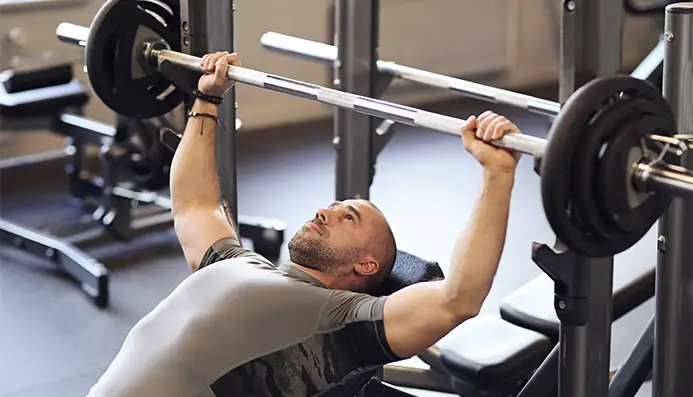When it comes to incline benching, there is some debate as to whether a 30 or 45-degree angle is more effective. Some people feel that the steeper 45-degree angle is better for targeting the upper chest, while others believe that the less severe 30-degree angle is a better overall chest exercise. So, which angle is actually more effective? let’s find out.
30 or 45-degree incline bench, which is more effective?
According to a study done in 2016 by the European Journal of sports science, it was found that a 30-degree angle when bench pressing activates more of the upper chest and lower chest muscles than a 45-degree angle. However, there is no difference in the amount of activation from both angles in the upper chest muscle.
The study found that a steeper bench angle (45 degrees or greater) resulted in greater activation of the chest, biceps, and shoulder muscles, while a flatter bench angle (less than 45 degrees) resulted in greater activation of the triceps and latissimus dorsi muscles. Thus, changing the bench angle can target different muscles during the bench press exercise.
The 30-degree incline bench press is a great exercise for developing the chest muscles. This exercise can be performed with a barbell or dumbbell. The 30-degree angle puts less stress on the shoulder joints than the 45-degree angle, making it a good choice for people with shoulder problems. Additionally, the 30-degree angle allows you to use more weight than the 45-degree angle, making it a good choice for people who are looking to increase their strength.
key differences between a 30 and 45-degree incline bench
There are a few key differences between a 30 and 45-degree incline bench. The first is the angle of the backrest. A 30-degree incline bench will put your back at a more upright angle than a 45-degree incline bench.
This can be beneficial if you have any lower back pain issues. Another difference is the angle of the seat. On a 30-degree incline bench, the seat will be more perpendicular to the ground.
This can make it more comfortable for some people and help them maintain good form during their workout.
Finally, the height of the bench may be different between a 30 and 45-degree incline bench. A taller person may feel more comfortable on a 45-degree incline bench, while someone shorter may prefer a 30-degree incline bench.
Which angle is best for you? Things to consider
There are a few things to consider when deciding whether a 30 or 45-degree incline bench is more effective for you.
First, think about your goals. If you’re trying to build muscle, the 45-degree incline bench might be better for you because it allows you to lift heavier weights.
On the other hand, if you’re trying to improve your cardiovascular fitness, the 30-degree incline bench might be a better option because it’s less likely to cause injury.
Second, consider your level of experience. If you’re new to working out, the 30-degree incline bench might be a better choice because it’s less challenging. As you become more experienced, you can try the 45-degree incline bench and see how your body responds.
Finally, listen to your body. Everyone is different, so what works for one person might not work for another. If you’re feeling pain or discomfort on the 45-degree incline bench, switch to the 30-degree incline bench and see if that’s more comfortable for you.
At the end of the day, there’s no right or wrong answer when it comes to choosing between a 30 or 45-degree incline bench. It’s all about finding what works best for you and your goals.
Is 60 degrees incline bench press a good idea?
There are a lot of different factors that go into whether or not 60 degrees is the ideal angle for your incline bench press. It ultimately depends on your individual goals, body type, and lifting experience. However, some experts believe that 60 degrees may be too steep of an incline for beginners, as it places greater stress on the shoulder joint.
Additionally, those with lower back pain or weak core muscles may also find this angle to be uncomfortable. Ultimately, it is important to experiment with different incline angles to see what feels best for you and provides the desired results.
How to do incline bench press properly
In order to do an incline bench press, you will need a few things: -A barbell -Weight plates -An incline bench
1. First, adjust the incline bench to the desired angle. Remember to keep the angle at a moderate level in order to avoid injury. Setting the bench to around a 30-45 degree angle is a good starting point.
2. For the average person, barbells are going to be the best option for this exercise. Place the barbell on the incline bench and add the desired amount of weight plates to each side of the barbell.
3. Once you have added the desired amount of weight, lie down on the bench and position yourself so that your eyes are level with the barbell.
4. Grab the barbell with an overhand grip, making sure that your hands are spaced out evenly. The width of your grip should be just outside of the shoulder width.
5. Take a deep breath in, and as you exhale, slowly lower the barbell down to your chest. Pause for a moment at the bottom of the lift, and then inhale as you press the barbell back up to the starting position. Exhale as you reach the top of the lift. That is one repetition.
Aim for 3-5 sets of 8-12 reps each. If you can do more than 12 reps per set, then increase the weight so that you’re challenged throughout the entire set.
What muscles activate during incline bench press?
The incline bench press is a great exercise for targeting the muscles of the chest, shoulders, and triceps. When performing this exercise, be sure to keep your back flat against the bench and your feet firmly planted on the ground. Here are the muscles that activate during incline bench press:
-Pectoralis major: This muscle is responsible for the movement of the shoulder joint and is activated when you press the weight up from the inclined position.
-Anterior deltoid: This muscle helps to stabilize the shoulder joint and is also activated when pressing the weight up from the inclined position.
-Triceps brachii: This muscle extends the elbow joint and is activated when you press the weight up from the inclined position.
Should you avoid the incline bench press?
If you’re looking to add some serious size to your chest, the incline bench press is a great exercise to incorporate into your routine. While you can certainly do other exercises for your chest, the incline bench press allows you to target your upper chest muscles more effectively. If you’re looking to build a well-rounded chest, then you should definitely include the incline bench press in your workout regimen.
Does a 30-degree incline bench only work on the upper chest?
The 30-degree incline bench press is a great exercise for targeting the upper chest, but it’s not an isolation exercise. The incline bench press also works the front deltoids, triceps, and serratus anterior. When performed with a proper lifting technique, the 30-degree incline bench press can help build muscle and strength in the upper body.









